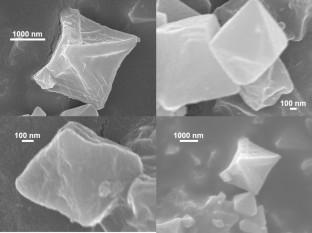Applied Magnetic Resonance ( IF 1 ) Pub Date : 2022-04-07 , DOI: 10.1007/s00723-022-01471-1 Carlos M. Hangarter 1 , Matthew Laskoski 1 , Mark C. Palenik 1 , Joel B. Miller 1 , Christopher A. Klug 1 , Boris Dyatkin 2

|
Among the many exciting potential applications for metal − organic frameworks (MOFs) is their use in electrodes for energy storage. Towards this goal, there have been many studies to evaluate MOFs in supercapacitors, including the work by Choi et al. (ACS Nano 8:7451, 2014. https://doi.org/10.1021/nn5027092) who evaluated a series of 23 porous MOFs. Here we present results from the synthesis and characterization of the Zr-MOF they identified as most promising, nMOF-867, Zr6O4(OH)4(BPYDC)6 (BPYDC = 2,2´-bipyridine-5,5·-dicarboxylate). Gas sorption measurements, powder X-ray diffraction (XRD), scanning electron microscopy (SEM), X-ray photoelectron spectroscopy (XPS), and cyclic voltammetry were used to characterize our materials and results are compared to those in the literature. In addition, we used solid-state nuclear magnetic resonance (NMR) to determine the local structure of this material. Comparisons were made between the observed 13C NMR chemical shifts for the pure linker, BPYDC, the final Zr-MOF, and density function theory (DFT) calculations. Ultimately, while we found that the electrochemical performance of the materials prepared in this study was poor, possibly due to their low surface area and instability, we confirmed the applicability of solid-state NMR to characterize the local structure of these and similar materials as we move further towards full in situ studies of MOF-based electrodes.
中文翻译:

锆 MOF 的综合理论和实验表征,具有在超级电容器中的潜在应用
金属有机框架 (MOF) 的许多令人兴奋的潜在应用之一是它们在电极中用于能量存储。为了实现这一目标,已经有许多研究来评估超级电容器中的 MOF,包括 Choi 等人的工作。(ACS Nano 8:7451, 2014. https://doi.org/10.1021/nn5027092) 评估了一系列 23 种多孔 MOF。在这里,我们展示了他们认为最有前途的 Zr-MOF、nMOF-867、Zr 6 O 4 (OH) 4 (BPYDC) 6的合成和表征结果(BPYDC = 2,2´-bipyridine-5,5·-dicarboxylate)。气体吸附测量、粉末 X 射线衍射 (XRD)、扫描电子显微镜 (SEM)、X 射线光电子能谱 (XPS) 和循环伏安法用于表征我们的材料,并将结果与文献中的结果进行比较。此外,我们使用固态核磁共振 (NMR) 来确定这种材料的局部结构。比较了观察到的13纯接头、BPYDC、最终 Zr-MOF 和密度函数理论 (DFT) 计算的 C NMR 化学位移。最终,虽然我们发现本研究中制备的材料的电化学性能很差,可能是由于它们的低表面积和不稳定性,但我们证实了固态核磁共振在表征这些材料和类似材料的局部结构方面的适用性。进一步向基于 MOF 的电极的全面原位研究迈进。


























 京公网安备 11010802027423号
京公网安备 11010802027423号